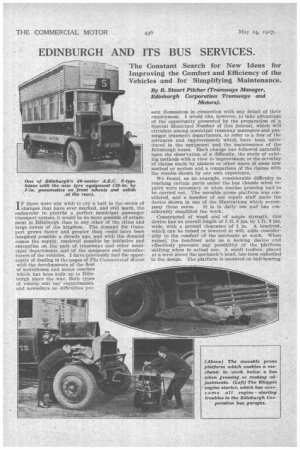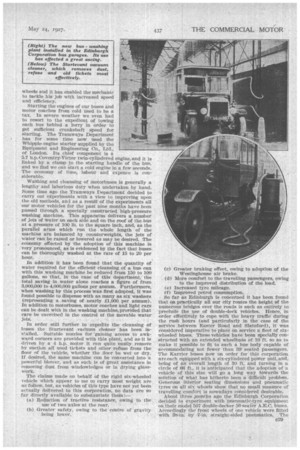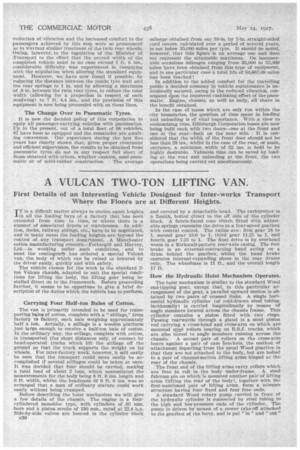EDINBURGH AND ITS BUS SERVICES.
Page 86

Page 87

Page 88

If you've noticed an error in this article please click here to report it so we can fix it.
The Constant Search for New Ideas for Improving the Comfort and Efficiency of the Vehicles and for Simplifying Maintenance.
By R. Stuart Pitcher (Tramways Manager, Edinburgh Corporation Tramways and Motors).
TF there were any wish' to cry a halt in the series of
changes that have ever marked, and still mark, the endeavour to provide a perfect municipal passenger transport system, it would be no More possible of attainment in Edinburgh than in any Other of the cities and large, towns of the kingdom. The demand for transport grows faster and greater than could have been imagined, possible a decade ago, and with the demand comes the supply, rendered possible by initiative and enterprise on, the -part of tramways and •other municipal departments and of the designers and manufacturers of the vehicles. I have previously had the opportunity of dealing in the pages of.The Commercial Motor with the developments of the fleet of motorbuses and motor coaches which has been built up in Edinhtirgh since the war. Both types of vehicle suit our requirements, and nowadays no difficulties pre sent themselves in connection with any detail of their employment. I would like, however, to take advantage of the opportunity presented by the preparation of a Special Municipal Number of this journal, which will circulate among municipal tramway managers and passenger transport departments, to refer to a few of the advances and improvements which have been introduced in the equipment and the maintenance of the Edinburgh buses. Each change has followed naturally upon the observation of a difficulty, the study of existing methods with a view to improvement or the scrutiny of claims made by Makers or other users of some new method or system and a comparison of the claims with the results shown by our own experience.
We found, as anexample, considerable difficulty in reaching certain parts under the bus chassis when repairs were necessary or when routine greasing had 'to be carried out. The movable prone platform was considered, and a member of our repair staff made the device shown in one of the illustrations which accom pany these notes. It is in daily use and has considerably simplified the work.
Constructed of wood and of ample strength, this device has an overall length of 5 ft. 6 ins. by 1 ft. 3 ins. wide, with a ground cle,arauce of 1 in. A headrest, which can be raised or lowered at will, adds consider' ably to the comfort of the mechanic at work. When raised, the 'headrest acts as a locking device end effectively prevents any possibility of the platform shifting ;when in actual use. A small toolbox, placed at a level above the mechanic's head, has been embodied in the design. The platform is mounted on ball-bearing
• wheels and it has enabled the mechanic • to tackle his job with increased speed and efficiency.
Starting the engines of our buses and motor coaches from cold used to be a tax. In severe weather we even had to resort to the expedient of towing each bus behind a lorry in order to get sufficient crankshaft speed for starting. The Tramways Department has for some time DOW used the Whipple engine starter supplied by the Equipment and Engineering Co. Ltd., of London. Its chief component is a 5.7 h.p.Coventry-Victor twin-cylindered engine, and it is linked by a clamp to the starting handle of the bus, and we find we can start a cold engine in a few seconds. The economy a time, labour and expense is considerable.
Washing and cleansing of motorbuses is generally a lengthy and laborious duty when undertaken by hand. Some time ago the Tramways Department decided to carry out experiments with a view to improving upon the old methods, and as a result of the experiments all our motor vehicles for the past nine months have been passed through a specially constructed high-pressure washing machine. This apparatus delivers a number of jets of water on each side and on the roof of the bus at a .pressure of 100 lb. to the square inch, and, as the parallel arms which run the whole length of the machine are balanced by counterweights, the jets of water can be raised or lowered as may be desired. The economy effected by the adoption of this machine is very pronounced, as is evidenced by the fact that buses can be thoroughly washed at the rate of 15 to 20 per hour.
In addition it has been found that the quantity of water required for the efficient cleansing of a bus can with this washing machine be reduced from 150 to 100 gallons, so that, in the case of this department, the total saving in water alone reaches a figure of from 3,000,000 to 4,000,000 gallons per annum. Furthermore, when washing by this process was first adopted, it was found possible to dispense with as many as six washers (representing a saving of nearly £1,000 per annum). In addition to motorbuses, motor coaches and light cars can be dealt with in the washing machine, provided that care be exercised in the control of the movable water jets. .
• In order still further to expedite the cleansing of buses the Sturtevant vacuum cleaner has been installed. Suitable nozzles for 'gaining access to awkward corners are provided with this plant, and as it is driven by a 4 h.p. motor it can quite 'easily remove by suction all used tickets and other refuse from the floor of the vehicle, whether the floor be wet or dry. If desired, the same machine can be converted into 8.. powerful blower, and as such is of great assistance in removing dust from windewledges or in drying glasswork:.
The claims made on behalf of the rigid six-wheeled vehicle which appear to me to carry most weight are as follow, but, as vehicles of this type have not yet been
I et u all y delivered to this corporation, no data are so far directly. available to substantiate them:—
(a) Reductien of tractive resistance, owing to the use of two axles at the rear.' • • (b) Greater safety, owing to the centre of gravitY being lower. (c) Greater braking effect, owing to adoption of the Westinghouse air brake.
(d) More comfort to the travelling passengers, owing to the improved distribution of the load.
(e) Increased tyre mileage.
• (f) Improved petrol consumption.
• So far as Edinburgh is concerned it has been found that on practically all our city routes the height of the numerous. bridges over the roads is such as entirely to preclude the use of double-deck vehicles. Hence, in order effectitely to cope with the heavy traffic during the rush hours (and particularly in the case of the service between Easter Road and Slateford), it was considered imperative to place on service a fleet of sixwheeled buses. These vehicles have been specially constructed with an extended wheelbaSe of 19 ft. so as to 'Make it possible to fit to each a bus body capable of accommodating not fewer than 39' seated Passengers. The Karrier buses now on order for this corporation are each eqUiPped with a six-cylindered power unit, and, being of an overall length of 30 ft, and turning in a circle of 66 ft., it is anticipated that the adoption of a vehicle of this size will go a long way towards the solution of what has hitherto been a difficult problem.
• Generous interior seating dimensions and pneumatic
• tyres on all six wheels show that no small measure of travelling 'Comfort is nowadays considered desirable. About three ynonths ago the Edinburgh Corporation decided to experiment With pneumatie4yre equipment oatheir Model 507 double-decker 56-seater A.E.C. buses. Accordingly the front wheels of one vehicle were fitted with 38-in. by •7-im straight-sided pneumatics. The c29 reduction of vibration and the increased comfort to the passengers achieved by this step were so pronounced as to warrant similar treatment of the twin rear wheels. -Owing, however, to the regulation of the Minister of .Transport to the effect that the overall width of the completedvehicle must in no case exceed 7 ft. 6 ins., considerable 'difficulty was experienced in complying with the stipulation when altering the standard equipment. However, we have now found it possible, by -reducing the distance between the inside tyre wall and the rear springs. to I in. and by allowing. a maximum of .8 in. between the twin rear tyres, to reduce the total width (allowing for a projection in respect of each mudwing) to 7 ft. 4.4 ins., and the provision. of this equipment is now being proceeded with on these lines.
The Change Over to Pneumatic Tyres.
It is now the decided policy of this corporation to equip all passenger-carrying vehicles with pneumatics. Up to the present, out of a total fleet of 98 vehicles, 87 have been so equipped and the remainder are awaiting conversion. Our eNperience during the last five years has clearly shown that, given proper .treatment and efficient supervision, the results to be obtained from pneumatic tyres do not in any respect fall short of those obtained with others, whether cushion, semi-pneu
matic or of solid-rubber construction. The average mileage obtained from our 38-in. by 7-in, straight-sided cord covers, calculated over a period of several years, is not below 35,000 miles per tyre. It should be noted, however, that this figure is an average one and does not represent the attainable maximum. On innumerable occasions mileages ranging from 35,000 to 55,000 miles have been obtained from this type of equipment, and in one particular case a total life of 64,667.09 miles has been reached !
In addition to the added comfort for the travelling public a decidedeconomy in vehicle maintenance Is undoubtedly secured; owing tO the reduced vibration, consequent Upon the imProved cushioning effect of the pneumatic. Engine, chassis, as well as body, all share in
the benefit obtained. .
In the case of buses which are only run within the city boundaries, the question of time spent in loading and unloading is of vital importance. . With a view to economizing time, Edinburgh Corporation buses are now ' being built each with two doors—one at ihe front and one at the rear—both on the near side. It is considered that the width of the front door should not be less than 28 ins., whilst in the case of the rear, or main, entrance, a. minimum width of 32 ins, is held to be highly desirable. Valuable time can be saved by loading at the rear and unloading at the front, the two Operations being carried out simultaneously.




















































































































































































